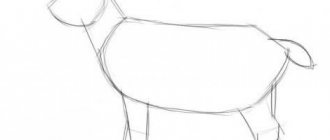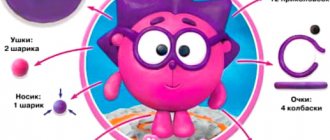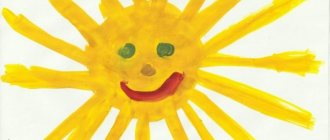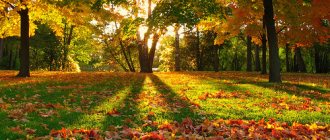MAGAZINE Preschooler.RF
Municipal budgetary preschool educational institution “Kindergarten No. 25 “Fairy Tale”” was prepared by teacher Napolskikh Larisa Sergeevna, Naberezhnye Chelny 2014 Goal: to have an idea of how bread is grown, to respect people who grow bread, to show interest in new knowledge. Objectives: • to give children knowledge about bread as the main wealth of man; • to introduce children to a new material for modeling - salted dough; learn to sculpt from salted dough, using familiar modeling techniques • develop dough techniques, creativity, fine motor skills of the hands • cultivate respect for bread, the main product on the table Materials and equipment: pictures, photographs, samples of cereals, proverbs and sayings about bread, ready-made salted dough Preliminary work: looking at illustrations, reading fiction about bread, reading poems and proverbs, preparing salt dough. Vocabulary work: baked goods, barn, kneading Preliminary work with children: conversation about how grain is grown, looking at pictures, excursions to a bakery store, reading poems and proverbs about bread, memorizing a poem for physical education, reading fiction Integration of educational areas: artistic creativity (modelling), cognition, communication, socialization, reading fiction. Types of children's activities: play, cognitive-research, communicative, productive. Introductory part. Educator: Listen to a poem about bread: Here it is, fragrant bread, Here it is warm, golden. He came to every house, to every table. It contains our health, strength, and wonderful warmth. How many hands raised him, protected him, took care of him. In it is the juice of the native land, the sun is the cheerful light in it... Grasp it by both cheeks, grow up to be a hero! Educator: Today we will talk about how they baked bread in the old days. Educator: -Tell me why they say “Bread is the head of everything?”, “What is bread made from?”, “What is another name for bread?” (example answers from children) Educator: - Guys, listen to the proverbs about bread: - “With bread, all food is delicious” - “Don’t open your mouth to someone else’s loaf” “Sweat on your back, so is bread on the table” Bread is the main product in our table. We cannot imagine our life without bread. But for bread to get to our table, it must travel a long way. After harvesting, the grain was ground in mills to produce flour. Then the flour was taken to the barns. A barn is a warehouse, a pantry where grains and cereals were stored. Educator: Now I will show you a simple way to obtain flour from wheat grains. (The teacher pours wheat grains into the coffee grinder and invites the children to observe what happens) Educator: The result is wheat cereal, from which you can cook delicious wheat porridge at home and in kindergarten. Well, if you grind longer, you get wheat flour. To bake bread, flour had to be sifted through a sieve. This was necessary so that debris did not get in and the flour became airy. Then the housewife kneaded the dough in a kneading bowl. Kvashnya is a wooden utensil for baking bread. When the dough rose, it was laid out on frying pans, and if there were none, on iron or simply placed on bricks. Bread was baked in the oven and taken out with wooden shovels. They took the fragrant bread out of the oven and covered it with towels so that it became soft. They cut off the top of the loaf, and a wonderful smell spread throughout the entire hut. Educator: -Tell me what else you baked from flour? (pies, cheesecakes, buns, bagels, etc.) (showing pictures)The main part of the GCD: Finger gymnastics “Spikelet” Educator: To make our fingers obedient, let’s stretch them. And we plowed the arable land, plowed deep furrows. (imitation of digging) The furrows are deep, the stripes are wide (hands up) We sow, sow, sow (imitation of sowing) We throw the grain into the arable land Go into the warm ground Rise up to the sun. (stretching upward) And we are young reapers, We have golden sickles. (imitation of the harvest) We reaped our lives, laid them in stacks in the fields, and put pies on the table. (imitation of an invitation to the table)
Educator: And now you will all be bakers. Put on your aprons and go to our bakery (children sit at the tables). The teacher invites the children to make gingerbread cookies, bagels, cookies, pies, loaves, etc. from salt dough for the game. During the work, the teacher helps and suggests how to decorate. Result: All the guys are great! Everyone worked hard and made so many baked goods. (At the end of the lesson, all works must be reviewed. Then the products are placed on a baking sheet and taken to the kitchen for baking).
List of used literature: 1. Averina I.E. Physical education minutes and dynamic pauses in preschool educational institutions: practical work. allowance / I.E. Averina. – 4th ed. – M.: Iris-press, 2008. 2. Komarova T.S. Lessons in visual arts in kindergarten: Book. for a kindergarten teacher garden – M.: Mozaika-Sintez, 2008. 3. Veraksa N.E., Komarova T.S., Vasilyeva M.A. From birth to school. Sample basic general education program for preschool education. – M.: Mosaika-Sintez, 2011.
| Next > |
GCD on modeling from salt dough" "Bread products". Testoplasty.
. Topic: “Bakery Products.” Testoplasty.
Goals and objectives:
· Introduce different types of bakery products;
· Clarify and consolidate knowledge about bakery products;
· Continue to develop children's creative imagination, fine and gross motor skills, memory, thinking, and eye;
· Develop the ability to convey the shape of familiar objects, their proportions, using previously learned modeling techniques;
· Cultivate accuracy and a positive attitude towards your work through the introduction of innovative technologies.
Preliminary work: - memorizing sayings and poems about bakery products; - looking at illustrations.
Vocabulary work: kneading, pinching, rolling.
Materials and equipment for the lesson: dough, modeling boards, stacks, napkins, rolling pins, samples of molded bakery products.
Modern educational technologies: health-saving, information and communication technologies, collaborative learning.
Progress of the lesson
Educator: - Guys, guests will come to us today.
— What do you think we can treat our guests to?
— Give me some tea (children’s answers)
Educator: - Yes, that’s right, but what can we offer for tea, made with our own hands?
(children's answers) - buns, muffins, pies, pretzels, bagels, baskets.
Educator: Guys, probably all these bakery products grow on trees, and we can pick them and serve them to the guests?
Children: No, does bread grow in the field?
Educator: Correct! I will now show you how bread gets to our table. (Demonstration of the presentation “Bread is the head of everything”)
Educator: You watched the presentation and, probably, you can tell me: What are the people who grow bread called? (grain growers)
—Where is grain transported by car from the fields? (to the elevator)
— What is an elevator? (building where grain is stored)
— What happens next to the grain?
From the elevator, the grain is transported to a flour mill, where flour is obtained from the grains, and then taken to a bakery, where bread is baked.
Educator: Well done! I suggest you take part in the process of obtaining flour and take the grain to the flour mill.
Physical exercise.
We are going to the field (children stand one after another and “drive” by car)
They hit a bump (they jump up, squat, make turns to the right, left)
We drove into a hole
We went around the hills
And the plant has arrived!
Educator: So we took the grain to the flour mill, and while our flour is ready, I suggest you go to your places.
Teacher: draws attention to the box standing on the table. He offers to solve riddles and with each answer he takes out a picture or a replica of a baked product from the box.
Salt dough recipe for bread and rolls
Salted dough for making miniature pastries should be plastic. The recipe is simple, the ingredients are available.
You will need:
- Fine salt - 200 g. We use Extra salt, without the addition of iodine, it is sold in a pack with a blue seal.
- Flour – 200 g. How to measure the required amount of flour and salt? If you have kitchen scales, there will be no difficulties. If there are no scales, you will have to measure with glasses or cups. Please note that weight and volume are different things; salt is much heavier than flour. We use the tips of experienced dough makers - take 1.5 cups of flour for 1 glass of salt. We do not compact the latter.
- Water – approximately 150 ml. Why "approximately"? The fact is that the flour is different, and you may need either a little less or a little more water.
- PVA glue – 1-1.5 tbsp. spoons.
- Vegetable oil – 1-15 tbsp. spoons.
The process of making salt dough is simple.
1. Pour water into a separate container, add PVA and vegetable oil. Mix.
2. Mix flour and salt in a bowl.
3. Pour the liquid gradually into the mixture of flour and salt. Mix the dough. No long kneading is required, just a couple of minutes.
4. Place the ball of dough in a plastic bag or wrap it in film. You can sculpt immediately after kneading, although some masters leave it to sit for an hour. We wrap it in film so that the dough does not dry out - its top layer dries out very quickly, and crumbs may form when sculpting.
Drying and finishing baked goods
Place the board with the buns to dry. If they will be dried in the air, place the crafts where they will not interfere, since drying will take several days - the salt dough will dry out approximately 1 mm per day.
Drying in the oven not only speeds up the process, but also allows you to get a beautiful “crust”. Dry in a low-heat oven for about half an hour, keeping the baked goods under constant control so as not to burn.
When the crafts have dried, grease them with milk (also using a brush for convenience). Put it in the oven again. And so 3-4 times.
If you want to get a white “sprinkling”, grease the buns/braids with a strong salt solution - when drying in the oven, the salt crystallizes and a “sprinkling” is formed. You also need to lubricate with saline solution several times.
A beautiful crust and “topping” can also be made on products that have dried in air. Exactly the same - using an oven.
You can paint toy baked goods with acrylic paints.
The final stage is to give the baked goods a shine. Acrylic varnish is suitable for this.
GCD on Artistic creativity for children of the senior group
GCD on Artistic creativity for children of the senior group.
Application with modeling elements “Magic Spikelet” Program objectives: 1. Give an idea of the extraction of flour 2. Develop the ability to perform an application with modeling elements 3. Continue to develop the ability to act in accordance with the scheme 4. Develop accuracy when performing the application 5. Continue to develop the skill of work with plasticine 6. Cultivate the desire to complete the task. Progress
of the lesson:
Children enter the group and say hello.
The teacher sits the children on chairs. There's a knock on the door. The cooks come in: - Hello! We are cooks, we help cooks in the kitchen. Today we wanted to bake buns for the afternoon snack, but we ran out of flour, and without it we won’t be able to bake buns! Educator: what to do? Children: Options for children (buy flour, etc.) Educator: Dear cooks, the guys in our group and I will come up with something and will definitely help you. Shall we help you guys? Children: Yes The cook comes in: Where are my cooks lost? I'm looking for you everywhere, let's go to the kitchen, I need your help. The cooks leave. Educator: Guys, how do we get flour? Where will we get it? Do you know what flour is made from? Children: children's options. Educator: I want to tell you more about this and invite you to look at the screen. Watch a presentation with teacher comments about where flour comes from. Educator: so where does flour come from? Children: from ears of wheat, grains of wheat, they grind it in a mill... Educator: Guys, what can you bake from flour besides buns? Children: Bagels, bread, loaf, cheesecakes... Educator: How can all this be called in one word? Children: Baking, bakery products, flour products. Educator: Choose words to describe baking. What is she like? Children: tasty, aromatic, fresh, rich, soft, appetizing. Educator: We have now learned that flour is obtained from the grain of ears of wheat and rye. Come to me, let’s remember once again how an ear sprouts, repeat after me. Fizminutka A grain fell into the ground, (squat) It began to sprout in the sun (hands above your head) The rain watered the ground, And the sprout grew (slowly stand up) Reached for the light and warmth (on tiptoes) And turned into a handsome man (show themselves). Educator: Tell me, has anyone seen a real spikelet? Children: children's answers Educator: Guys, I brought spikelets to the group today, look at them (Children look, touch). Why is the ear called golden? Children: Children's options. (it is yellow, similar in color to gold...) Educator: Correct. And also, guys, the ear is called golden because the product that is made from wheat grain - bread - is very valuable for us, which is why it is compared to gold. Do you agree with me? Children: Yes Educator: Look, what does the ear consist of? That he has? Children: Stem, grain, tendrils. Educator: Guys, have any of you ever been to a grain (wheat) field? Children: children's answers Educator: today I have prepared a small field of grain for you, look at it Breathing exercise “Field of Bread” Educator: In the summer, the entire field is planted with wheat in golden ears. Ears of grain are like the sea. The wind blows and the ears turn into golden waves. Let's try to blow on the “grain field”? Let's stretch out the lips like a tube and pretend to be a breeze. (Children blow on a model of a grain field). Does it look like a wheat field? Children: Yes. Educator: We are doing well, and now I invite you to sit down at the tables. Working at tables. Educator: Guys, what do you see on the tables? Children: Plasticine, stacks, blank leaves, pumpkin seeds, felt-tip pens. Educator: What do you think we will do now? Children: Spikelet Educator: Are you ready? Children: Yes. Educator: then let’s prepare our fingers for work, stretch them by doing finger exercises. Finger gymnastics. We asked our oven What should we bake today? We asked for the stove, Kneaded the dough, Rolled out the dough with a rolling pin, Rolled it out without getting tired, Stuffed it with cottage cheese And called it a pie! Come on, give me a place, stove, there’s a place for the cottage cheese maker! Educator: Well done. Now look at the diagram that I have prepared for you. (The teacher shows a diagram of the sequence of making a spikelet)
.
What do you think this circuit is for? Children: to know what to do first and what to do later. The teacher explains in detail each stage of the work. Doing the work Educator: Guys, let’s give these magic spikelets to the miller at the mill. He will grind the grain from the magic ears into flour so that the cooks can bake them into magic buns for the afternoon snack. Children: Let's go. Educator: Show each other your work, you made some wonderful spikelets. Put them aside, take a napkin and wipe the plasticine off your hands. Reflection. Educator: Guys, stand in a circle, I want you to share your impressions. Now we will pass the ball around the circle, whoever has the ball in his hands will tell what he learned today, what he liked most and what was the most difficult. Words of gratitude from the teacher: I also liked today’s lesson, and most of all, the fact that you were active, attentive, and tried very hard when doing the spikelets. Thank you. Now, let's get our workspaces in order.
We recommend watching:
Summary of GCD in the senior group. A journey through Chukovsky's fairy tales. Notes on direct educational activities in the senior group for children with mental retardation. Notes on cognitive and research activities in the senior group. Notes on educational activities in the senior group on the topic “How to see the air.”
Similar articles:
Summary of a safety lesson in the senior group: Safety in nature
Lesson on basic safety in the senior group. Topic: Rules of conduct while walking
Life safety tasks for children 5-7 years old
How to make bakery crafts from salt dough
Everything is extremely simple. We pinch off a small piece of dough from the ball and form the product we need: bread, bun, bagel, braid, etc.
We sculpt on a dry kitchen board. We put it on the same board - wooden or plastic. We do not lubricate the boards with anything.
If you need to connect the parts of the product, glue them together using ordinary water. Since salt dough crafts are small, it is convenient to use a brush when gluing.





